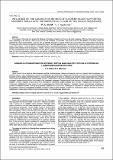Search
Influence of the connection method of floor-by-floor supported masonry walls with the supporting floor on the crack resistance

View/
Date
2024Publisher
БрГТУUDC
692.21Citation
Novik, Р. А. Influence of the connection method of floor-by-floor supported masonry walls with the supporting floor on the crack resistance = Влияние на трещиностойкость поэтажно опертых каменных стен способа их сопряжения с поддерживающим перекрытием / Р. А. Novik, V. I. Yuskovich. – Text : direct // Vestnik of Brest State Technical University. – 2024. – № 3. – P. 43–46. – Bibliography: 23 titles.Abstract
The purpose of this article is to analyze the influence of deflections of supporting floors on the crack resistance of floor-by-floor supported masonry walls, depending on the method of their connec-tion with the reinforced concrete floor. This article shows that the deflection of the floor causes the appearance of main tensile stresses in the wall with the doorway, the maximum values of which are concentrated in the corner areas of the opening. Toreduce the risk of cracks in the wall filling between the masonry and the supporting floor, it is recommended to install a separating layer of one or two layers of film material. In case of deflection of the supporting floor the separating layer allows to exclude the transfer ofload to the walls, which may be caused by the adhesion of the leveling layer of mortar to the floor. It has been established that an increase of the coefficientof friction between the wall and the supporting floor leads to a decrease in the main tensile stresses in the corner area of the doorway. Therefore, when constructing a separating layer, it is not recommended to perform it at the end sections of the filling. Based on numerical studies, the dependence of themain tensile stresses in apartition with a doorway on the value of the coefficient of friction between the surfaces of the masonry and the supporting floor.
Annotation in another language
Целью данной статьи является анализ влияния прогибов поддерживающих перекрытий каменной кладки на трещиностойкость каменных стен поэтажно опертых стен в зависимости от способа их сопряжения с железобетонным перекрытием. В данной статье показано, что прогиб перекрытия вызывает в стене с дверным проемом появление главных растягивающих напряжений, максимальные значения которых концентрируются в угловых зонах проема. Для снижения риска возникновения трещин в стеновом заполнении между каменной кладкой и опорным перекрытием рекомендуется устраивать разделительный слой из одного-двух слоев пленочного материала. Разделительный слой позволяет при прогибе перекрытия исключить передачу на стены нагрузки, которая может быть обусловлена сцеплением выравнивающего слоя раствора с перекрытием. Установлено, что увеличение коэффициента трения между стеной и поддерживающим перекрытием приводит к снижению главных растягивающие напряжения в угловой зоне дверного проема. Поэтому при устройстве разделительного слоя его не рекомендуется выполнять на концевых участках заполнения. На основании численных исследований построена зависимость главных растягивающих напряжений в перегородке с дверным проемом от величины коэффициента трения между поверхностями каменной кладки и поддерживающим перекрытием.
Collection
- № 3 (135) 2024 [28]

Это произведение доступно по лицензии Creative Commons «Attribution-NonCommercial» («Атрибуция-Некоммерчески») 4.0 Всемирная.